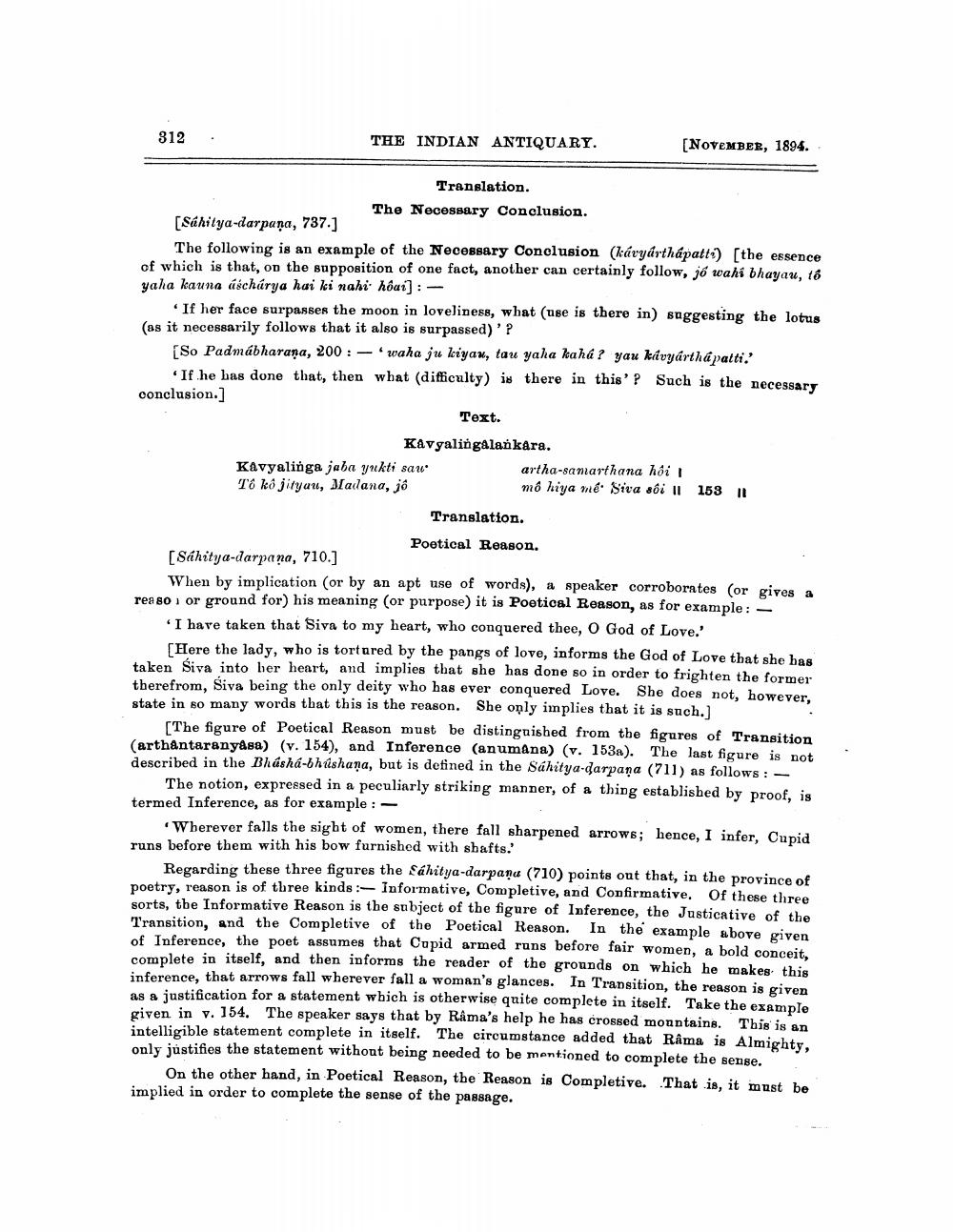________________
312
.
THE INDIAN ANTIQUARY.
[NovemBER, 1894.
Translation.
The Necessary Conclusion. [Sahitya-darpaņa, 737.]
The following is an example of the Necessary Conclusion (kávyárthápatts) [the essence of which is that, on the supposition of one fact, another can certainly follow, jó wahi bhayau, tô yaha kauna aścharya hai ki nahi hôi]: -
If her face surpasses the moon in loveliness, what (use is there in suggesting the lotus (as it necessarily follows that it also is surpassed) '?
[So Padmábharana, 200:-waha ju kiyau, tau yaha kaha ? yau kávyárthápatti.'
If he has done that, then what (difficulty) is there in this'? Such is the necessary conclusion.]
Text.
Kavgalingalankara. Kavyalinga jaba yukti sau.
artha-samarthana hồi ! T8 ko jityar, Jalana, jó
mô liga nể: Sita sồi || 158 It
Translation.
Poetical Reason. [Sahitya-darpana, 710.]
When by implication (or by an apt use of words), a speaker corroborates (or gives a resso or ground for) his meaning (or purpose) it is Poetical Reason, as for example: -
I have taken that Siva to my heart, who conquered thee, O God of Love.'
Here the lady, who is tortured by the pangs of love, informs the God of Love that she has taken Śiva into ber heart, and implies that she has done so in order to frighten the former therefrom, Siva being the only deity who has ever conquered Love. She does not, however. state in so many words that this is the reason. She only implies that it is such.
The figure of Poetical Reason must be distinguished from the figures of Transition (arthantaranyasa) (v. 154), and Inference (anumana) (v. 153a). The last figure is not described in the Bhúshá-bhúshana, but is defined in the Sahitya-darpana (711) as follows:
The notion, expressed in a peculiarly striking manner, of a thing established by proof, is termed Inference, as for example: -
Wherever falls the sight of women, there fall sharpened arrows; hence, I infer, Cupid runs before them with his bow furnished with shafts.'
Regarding these three figures the Sahitya-darpaņu (710) points out that, in the province of poetry, reason is of three kinds - Informative, Completive, and Confirmative. Of these three sorts, the Informative Reason is the subject of the figure of Inference, the Justicative of the Transition, and the Completive of the Poetical Reason. In the example above given of Inference, the poet assumes that Cupid armed runs before fair women, a bold conceit, complete in itself, and then informs the reader of the grounds on which he makes this inference, that arrows fall wherever fall a woman's glances. In Transition, the reason is given as a justification for a statement which is otherwise quite complete in itself. Take the example given in v. 154. The speaker says that by Råma's help he has crossed mountains. This is an intelligible statement complete in itself. The circumstance added that Râma is Almighty, only justifies the statement without being needed to be mentioned to complete the sense.
On the other hand, in Poetical Reason, the Reason is Completive. That is, it must be implied in order to complete the sense of the passage.




